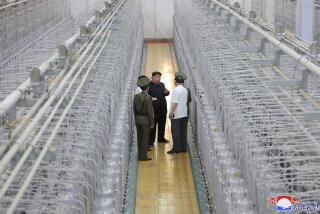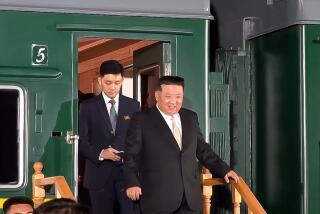N. Korea to Allow Look at Reactor
- Share via
WASHINGTON — North Korea has agreed to allow a private American group to visit its premier nuclear weapons complex, a move U.S. government officials hope will shed light on the facilities at the center of a 14-month diplomatic standoff.
The U.S. group, which includes nuclear scientists, congressional aides and former government officials, plans to visit the Yongbyon site, a member of the group said Friday. The four-day trip, scheduled to start Tuesday, would be the first visit to the facility by foreigners since North Korea ejected international inspectors a year ago, deepening a crisis over its nuclear arms program.
The North Koreans appear to want to show off their progress at the nuclear plant, experts said, and thus strengthen their bargaining position in advance of six-party talks on the communist regime’s weapons program. The talks are expected to be held early this year, although no date has been set.
U.S. officials stressed that they did not encourage the trip, but said they would be interested in any new intelligence on the Yongbyon complex, about 60 miles north of the capital, Pyongyang. U.S. government officials are usually briefed after such private visits, called “track two” diplomacy.
North Korea, which wants security guarantees and various subsidies from the United States before it ends its nuclear weapons program, has declared that it has reprocessed 8,000 spent nuclear fuel rods at Yongbyon. That would probably yield enough plutonium to enable the country to build six atomic weapons, in addition to the one or two bombs Washington believes it already has.
The U.S. group consists of nuclear scientist Siegfried S. Hecker, a former director of the Los Alamos National Laboratory; Charles L. Pritchard, a former U.S. ambassador and special envoy for negotiations with North Korea; Frank Januzzi, a senior aide to Sen. Joseph R. Biden Jr. (D-Del.); Keith Luse, a senior aide to Sen. Richard G. Lugar (R-Ind.), chairman of the Senate Foreign Relations Committee; and John W. Lewis, professor emeritus and China scholar at Stanford University.
Lewis, who has made a number of trips to North Korea and helped organize the delegation, left for China this week and was unavailable for comment.
White House spokeswoman Claire Buchan said, “It should be clearly understood that groups or individuals acting outside the six-party talks would not be acting on behalf of, or with the approval of, the administration.” She said the Bush administration believes that the upcoming six-party talks represent “the appropriate format for addressing the North Korea nuclear issue.” The other members of the six-party group are China, Japan, South Korea and Russia.
At the same time, the Bush administration did not go out of its way to discourage the trip, as some lawmakers said it did with a trip that was to have taken place in October. A group led by Rep. Curt Weldon (R-Pa.) had been invited by North Korea but canceled its plans, reportedly, in the face of the administration’s opposition.
Hecker, who is still a contract employee of the Energy Department, was given clearance by the department to take this trip, a U.S. official said.
North Korea policy experts said Pyongyang would keep a tight rein on the visitors and use the trip to make political points. Even so, it could offer insights into North Korea’s thinking, and might even turn up some intelligence about the huge site.
Robert J. Einhorn, former assistant secretary of State for nonproliferation, said the invitation suggests “that they have some specific objective in mind” and that it may be to demonstrate that they now have a deterrent capability -- a point Pyongyang apparently wanted to make to Weldon’s group.
Einhorn speculated that the U.S. government is probably highly conflicted about the visit.
Although the trip “is a vehicle that can be shaped by the North Koreans to make whatever point they want to make ... perhaps the administration at least feels the team could learn something” since no outsider has been inside the plant for so long.
Eric Heginbotham, an Asia policy specialist at the Council on Foreign Relations, said the North Koreans would probably want to convey that they want to make a deal with the United States but at the same time show that they are moving ahead quickly with their nuclear arms program in case the Bush administration balks.
He said U.S. officials may have been reluctant to halt this trip because they could miss out on valuable information, and could be criticized for failing to take advantage of an opportunity to make progress on the issue.
The latest crisis over North Korea’s nuclear plans began in October 2002, when U.S. officials said Pyongyang had disclosed that it had carried on a secret uranium-based nuclear arms program, in violation of a 1994 nuclear freeze agreement with the United States.
Since inspectors with the International Atomic Energy Agency were forced to leave, the United States has relied largely on satellite images and samples of the air in the region to assess what might be going on at the site, experts said.
More to Read
Sign up for Essential California
The most important California stories and recommendations in your inbox every morning.
You may occasionally receive promotional content from the Los Angeles Times.











